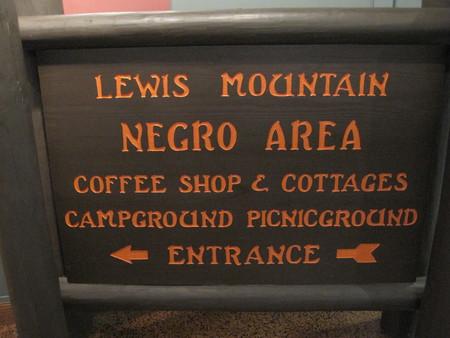The Lewis Mountain area at Skyline drive milepost 57.5 in Virginia's Shenandoah National Park was once a racially segregated facility. The mystery photo shows part of a replica sign on exhibit in the park's Harry F. Byrd, Sr. Visitor Center at Big Meadows. The original sign, one side of which is shown in an accompanying photo, was removed six decades ago when Lewis Mountain ceased to be racially restricted.
Racial segregation was built into the park's original plan. In 1932, three years before Shenandoah National Park was officially established, Arno Cammerer (then-Deputy Director of the National Park Service) had specified that concession facilities for the proposed park should make "provision for colored guests." A proposed "colored picnic grounds at Lewis Mountain" was in the park master plan, but no such facility had materialized by mid-summer 1937 when the Washington office, irked by the delay, sent a blunt reminder to park superintendent J. Ralph Lassiter:
There is a growing demand for picnic areas for colored people.... Two bus loads are going up tomorrow and they have to be fitted into camping places for white people. This is not a good condition....
Work on the facility soon commenced, though not with the CCC labor that was used elsewhere in the park. Portions of the new facility, called the Lewis Mountain Negro Area, were opened in summer 1939 and the first cabins and lodge were in service the following summer. From 1939 to 1950, Lewis Mountain was operated on the "separate but equal" principle that was widely practiced -- and endorsed by the courts -- during the pre-Civil Rights era of institutionalized racial segregation in America.
Lewis Mountain Negro Area facilities were not really equal to facilities provided for whites. To avoid constitutionality challenges, the park decided to racially integrate one other area of the park (initially the Pinnacles picnic grounds).
The desegregation of Shenandoah National Park did not come quickly or easily, but it did come long before state parks were desegregated in Virginia and other states of the Old South. In December 1945, the National Park Service sent a general bulletin to concessionaires informing them that full desegregation of all national parks had been mandated (Federal Register, December 8, 1945, page 14866). This action was delayed for years in Shenandoah because the park's concessionaire, Virginia Sky-Line Company, threatened to give up its contract if it couldn't operate on a whites-only basis. Despite this resistance, park facilities were gradually integrated until full integration was achieved by summer 1950.
Today, Shenandoah's Lewis Mountain area has a small campground (31 sites), cabins, and picnic facilities. The area remains popular with visitors who want a place that's smaller, quieter, and more private than the resort-like facilities at Big Meadows and Skyland.







Comments
Thank you for telling and showing the truth, how so very separate and unequal this nation was.
Ddi YOU make this sign?
I don't know who made the "like new" replica sign shown in the photograph.
My family stayed at Lewis Mountain Lodge during the period of segregation. It was well-Run and the restaurant was superb!
Thank you for posting this history. I had no idea that National Parks had been desegregated in 1945!